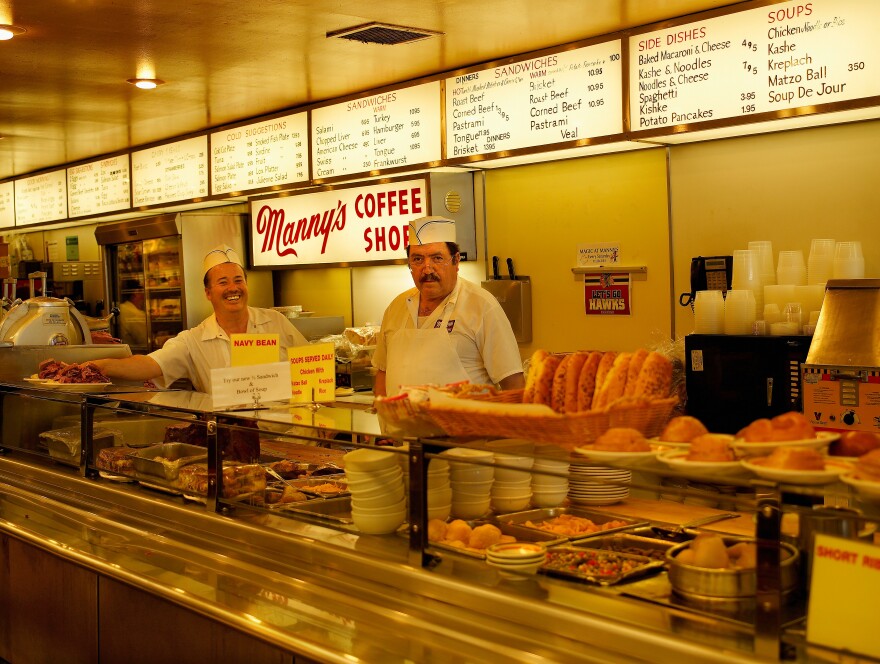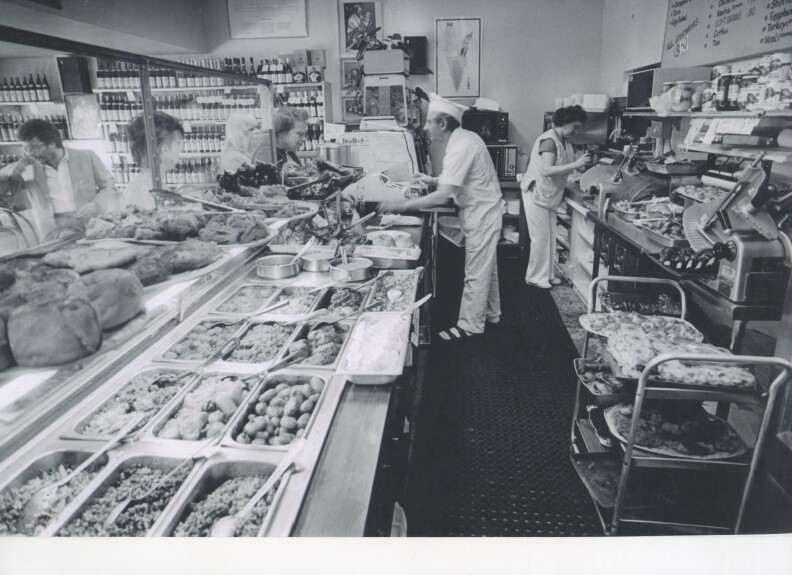With our free press under threat and federal funding for public media gone, your support matters more than ever. Help keep the LAist newsroom strong, become a monthly member or increase your support today during our fall member drive.
Hungry? Here's An Exhibit For You To Nosh On


When Skirball Cultural Center curator Laura Mart thinks of the Jewish deli, it’s not the food, but the sounds, that come to mind:
“You walk in, and there are people coughing, eating, scraping plates, taking their orders, laughing, chatting,” she said. “Many people say it’s their home away from home.”
It’s that hustle and bustle that Mart and co-curator Cate Thurston sought to capture in “I’ll Have what She’s Having,” an exhibit exploring the Jewish American experience through the lens of the Jewish deli.
The show traces how the deli evolved from a specialty shop for immigrants into a national institution, bringing deli culture to life with food displays and mid-century memorabilia including menus, matchbooks and bright neon signs. The exhibit also touches on the deli’s role as a community space: Mart says for many Holocaust survivors who rebuilt their lives in the U.S., delicatessens provided a livelihood, a purpose and a place to gather.
It’s the theme of immigration that runs through the exhibit — Thurston says the exhibit is not only for show, it makes an argument for deli food as a “uniquely North American cuisine,” a fusion born of Eastern Europeans encountering new cultures in the U.S.

Mart says this is reflected in the regional variations of delis. “You can find rice and beans on deli menus in the Southwest, and health food options in California,” she said.
No two delis are exactly alike, and menu variations can be as granular as matzo ball size — some delis serve up smaller balls, while others go large. Mart says part of the fun was learning about the stories behind the recipes, like the reason for the giant matzo balls at L.A.’s own Canters Delicatessen on Fairfax:
“The person whose duty it was to make the matzah balls in the kitchen was developing arthritis in her hands,” said Mart. “As it progressed, she couldn't make them smaller, she just kept making them bigger and bigger, so you end up with these enormous softball-sized matzah balls.”

The deli has not only influenced American palettes, it’s also made its way into pop culture. The exhibit features a clip reel of deli moments on film from Seinfeld to Mad Men, including the exhibit’s namesake scene — yes that scene — from When Harry Met Sally.
Thurston says these deli moments in movies and TV shows reflect the “landscape of feelings” the deli evokes.
“The deli is so many different things,” said Thurston, “So I think if somebody has a reaction to it, where they find it alluring and sexy, that's the deli for them. The deli could be a place where they go with their grandmother, and it's none of those things, right?”
The exhibit continues through early September.
At LAist, we believe in journalism without censorship and the right of a free press to speak truth to those in power. Our hard-hitting watchdog reporting on local government, climate, and the ongoing housing and homelessness crisis is trustworthy, independent and freely accessible to everyone thanks to the support of readers like you.
But the game has changed: Congress voted to eliminate funding for public media across the country. Here at LAist that means a loss of $1.7 million in our budget every year. We want to assure you that despite growing threats to free press and free speech, LAist will remain a voice you know and trust. Speaking frankly, the amount of reader support we receive will help determine how strong of a newsroom we are going forward to cover the important news in our community.
We’re asking you to stand up for independent reporting that will not be silenced. With more individuals like you supporting this public service, we can continue to provide essential coverage for Southern Californians that you can’t find anywhere else. Become a monthly member today to help sustain this mission.
Thank you for your generous support and belief in the value of independent news.

-
Flauta, taquito, tacos dorados? Whatever they’re called, they’re golden, crispy and delicious.
-
If California redistricts, the conservative beach town that banned LGBTQ Pride flags on city property would get a gay, progressive Democrat in Congress.
-
Most survivors of January's fires face a massive gap in the money they need to rebuild, and funding to help is moving too slowly or nonexistent.
-
Kevin Lacy has an obsession with documenting California’s forgotten and decaying places.
-
Restaurants share resources in the food hall in West Adams as Los Angeles reckons with increasing restaurant closures.
-
It will be the second national day of protest against President Donald Trump.







